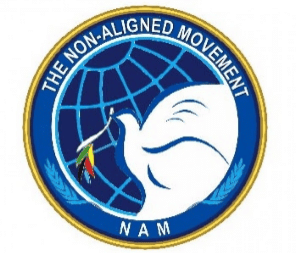Non-Aligned Movement (NAM) | Political Science for CUET(PG) - CUET PG PDF Download
| Table of contents |

|
| Non-Aligned Movement (NAM) Overview |

|
| Begininig of NAM |

|
| Relevance of the Non-Aligned Movement (NAM) |

|
| Guests and Virtual Engagement |

|
Non-Aligned Movement (NAM) Overview

The Non-Aligned Movement (NAM) is an international organization dedicated to advancing the interests and aspirations of developing countries. By the early 21st century, NAM had 120 member states. It emerged from the decolonization wave following World War II. At the 1955 Bandung Conference, attended by many newly independent nations, there was a call for "abstention from the use of collective
defense arrangements to serve the particular interests of any major powers."
Begininig of NAM
- The idea for the group started in 1955 during talks at the Asia-Africa Bandung Conference in Indonesia.
- The first Non-Aligned Movement (NAM) Summit Conference occurred in Belgrade, Yugoslavia, in September 1961.
- As of April 2018, NAM has 120 members, which includes:
- 53 countries from Africa
- 39 countries from Asia
- 26 countries from Latin America and the Caribbean
- 2 countries from Europe (Belarus and Azerbaijan)
- There are 17 countries and 10 international organizations that participate as Observers in NAM.
- The Non-Aligned Movement was established and held its first conference, known as the Belgrade Conference, in 1961. This was led by:
- Josip Broz Tito from Yugoslavia
- Gamal Abdel Nasser from Egypt
- Jawaharlal Nehru from India
- Kwame Nkrumah from Ghana
- Sukarno from Indonesia
- The goal of NAM was outlined in the Havana Declaration of 1979, which aimed to protect the national independence, sovereignty, territorial integrity, and security of non-aligned countries in their fight against imperialism, colonialism, neo-colonialism, racism, and all forms of foreign domination.
- During the Cold War, NAM played a crucial role in helping to stabilize the global order and maintain peace and security. The principle of non-alignment does not imply a state’s neutrality on global issues; rather, it advocates for a peaceful involvement in world politics.
Principles
NAM's principles, influenced by the Panchsheel principles, include:
- Respect for the political, economic, social, and cultural diversity of countries.
- Advocacy for shared interests, justice, and cooperation based on mutual respect and equality of rights.
- Recognition of the inherent right to self-defense in accordance with the UN Charter.
- Non-interference in the internal affairs of states.
- Adherence to the principles of the UN Charter and international law.
- Respect for sovereignty, sovereign equality, and territorial integrity of all states.
- Peaceful resolution of international conflicts in line with the UN Charter.
NAM During the Cold War
- Disarmament: NAM advocated for peace, the cessation of the arms race, and the peaceful coexistence of all states. India submitted a draft resolution in the UN General Assembly calling for the prohibition of nuclear weapons.
- Against Apartheid: NAM addressed apartheid from its inception, warning against discriminatory practices, particularly during the 2nd NAM Conference in Cairo.
- UNSC Reforms: NAM consistently supported reforms to the UN Security Council, opposing US and USSR dominance and calling for more representation for developing countries. This demand was reiterated at the 17th NAM Conference in Venezuela.
India’s Role and Shift in Focus
- As a founding member and major participant, India played an active role in NAM meetings until the 1970s. However, its alignment with the USSR led to confusion among smaller member states, weakening NAM and causing some nations to align with either the US or USSR.
- India's Prime Minister skipped the 17th NAM summit in Venezuela in 2016, marking only the second instance of a Head of State missing a NAM conference.
- NAM's relevance for India has declined in a unipolar world, especially after key members failed to support India in crises, such as the 1962 war with China and subsequent conflicts. India has increasingly integrated into the liberal economic order and has declared itself a nuclear power, moving away from the call for global nuclear disarmament. India has also engaged with both new and traditional global powers, exemplified by its participation in the Quad and the Shanghai Cooperation Organization.
Future Global Dynamics
- The world is moving towards a bipolar order, with the US and China-Russia as major powers. The conflict in Syria exemplifies this shift, with both US and Russia asserting their influence.
- Tensions in the Indo-Pacific region are escalating due to China's assertiveness, with the US acting as a counterbalance.
- Large-scale migration due to unstable regimes and ethnic conflicts in Europe and Asia is a significant issue.
- Global climate change and catastrophic disasters are driving the need for a global consensus on addressing these challenges.
- Changing US policies, protectionism, terrorism, nuclearization of the Middle East, and the formation of regional economic groupings like TPP and RCEP are reshaping the global arena, with multilateral bodies like the WTO losing influence.
Relevance of the Non-Aligned Movement (NAM)
- Equitable World Order: NAM promotes a fair global order and can bridge political and ideological divides in the international arena.
- Advocacy for Developing Countries: NAM serves as a platform for resolving disputes between developed and developing nations, such as those involving the WTO, facilitating peaceful negotiations and favorable outcomes for its members.
- Cultural Diversity and Human Rights: In contexts of severe human rights violations, NAM provides a platform to highlight and address these issues based on its principles.
- Sustainable Development: NAM supports sustainable development and can lead global efforts toward sustainability. It provides a forum to build consensus on critical global issues like climate change, migration, and terrorism.
- Economic Growth: NAM member countries possess assets such as favorable demographics, demand, and strategic locations. Their cooperation can foster higher and more sustainable economic growth, serving as an alternative to regional groupings like TPP and RCEP.
- South-South Cooperation: The Non-Aligned Movement Centre for South-South Technical Cooperation (NAM CSSTC) in Jakarta, Indonesia, focuses on enhancing the capacity and self-reliance of developing countries. Other NAM centres, located in Cuba, Iran, and India, concentrate on health, human rights, and technology.
Ministerial Meetings and Events
- Various ministerial meetings occur between summit gatherings, including specialized events like the "Inter-Faith Dialogue and Cooperation for Peace" held in Manila, Philippines, from March 16-18, 2010.
- General Conferences of Foreign Ministers are held every three years, with recent meetings in Bali, Indonesia (May 23-27, 2011), and Algiers, Algeria (May 26-29, 2014).
- NAM celebrated its 50th anniversary in Belgrade on September 5-6, 2011.
- An online summit titled "United Against COVID-19," held on May 4, 2020, addressed the global response to the COVID-19 pandemic and aimed to enhance NAM's role in mitigating the disease's impact.
- NAM celebrated its 60th anniversary in Belgrade on October 11-12, 2021.
Guests and Virtual Engagement
Guest Participation
- There is no permanent guest status within NAM, but non-member countries are often invited as guests to conferences. Additionally, numerous organizations from both within and outside the UN system are regularly invited as guests.
Virtual Non-Aligned Movement (NAM):
- The online NAM Contact Group Summit, themed “United Against COVID-19,” was hosted by the then-chairman of NAM, President Ilham Aliyev of Azerbaijan.
- The summit, convened at President Aliyev's initiative, took place on May 4, 2020. Indian Prime Minister Narendra Modi participated via video conference, marking his first NAM Summit appearance since assuming office in 2014.
- Over 30 Heads of State and Government, as well as other leaders from NAM member states in Asia, Africa, Latin America, the Caribbean, and Europe, attended the summit. The event also featured addresses from the UN General Assembly President and the World Health Organization (WHO) chief.
- Prime Minister Modi had previously skipped the NAM Summits in 2016 and 2019.
Fundamental Points of the Virtual Meeting
- Adoption of the Declaration: The summit adopted a declaration emphasizing the importance of international solidarity in combating COVID-19.
- Creation of a Task Force: A ‘Task Force’ was established to assess and address the needs of member states. A common database will be created to reflect the basic medical, social, and humanitarian needs related to the pandemic.
India’s Role at the Summit
Contribution to the COVID-19 Fight: India, recognized as the "pharmacy of the world" for its affordable medicines, continued to supply medicines to 123 countries, including 59 NAM members, despite its own pandemic challenges. India also actively contributed to global efforts to develop COVID-19 remedies and vaccines.
Participation in NAM Health Minister Meet: On May 20, 2020, India’s Health Minister Harsh Vardhan attended a NAM meeting via video conference, chaired by Azerbaijan’s Health Minister Ogtay Shiraliyev. India highlighted its contributions, including medical supplies to over 123 countries, 59 of which are NAM members.
NAM Summits
- 1st Summit: September 1-6, 1961, Belgrade, Yugoslavia
- 2nd Summit: October 5-10, 1964, Cairo, Egypt
- 3rd Summit: September 8-10, 1970, Lusaka, Zambia
- 4th Summit: September 5-9, 1973, Algiers, Algeria
- 5th Summit: August 16-19, 1976, Colombo, Sri Lanka
- 6th Summit: September 3-9, 1979, Havana, Cuba
- 7th Summit: March 7-11, 1983, New Delhi, India
- 8th Summit: September 1-6, 1986, Harare, Zimbabwe
- 9th Summit: September 4-7, 1989, Belgrade, Yugoslavia
- 10th Summit: September 1-6, 1992, Jakarta, Indonesia
- 11th Summit: October 14-20, 1995, Cartagena de Indias, Colombia
- 12th Summit: August 29-September 3, 1998, Durban, South Africa
- 13th Summit: February 20-25, 2003, Kuala Lumpur, Malaysia
- 14th Summit: September 11-16, 2006, Havana, Cuba
- 15th Summit: July 11-16, 2009, Sharm el Sheikh, Egypt















